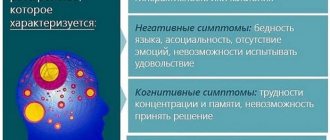History of the development of post-traumatic stress disorder
A description of the signs of PTSD can be found in the works of ancient philosophers. Thus, Herodotus and Lucretius noticed that after military operations, soldiers become anxious and irritable; painful memories of the war do not allow them to calmly engage in everyday affairs. This is what led to the discovery of PTSD or post-traumatic stress disorder. Ancient thinkers began to conduct various experiments, trying to explain what PTSD is in humans based on data from introspection, conversations, and observations.
But in the works of ancient thinkers one can only find a description of the symptoms and consequences of PTSD; ancient philosophers did not come up with a name for this phenomenon.
PTSD syndrome received its modern name only in the 20th century, when enough information was collected about it and scientists were able to develop methods for identifying it. Previously, in the literature, the disease PTSD was called traumatic neurosis.
Thus, the term PTSD came to psychology from ancient philosophy. Psychological research has proven that this post-traumatic stress disorder does not go away without psychotherapeutic help.
The modern understanding of PTSD in psychology is a psychoneurotic illness caused by negative emotional experiences of a person.
List of books
You can learn more about stress disorders and post-traumatic conditions from the following books.
- Vakhov V.P., Kolmanov G.B. “States of mental maladaptation and their correction in conditions of natural disasters and catastrophes” this source describes psychiatric and medical-psychological issues of diagnosis and assistance in disasters and environmental crises.
- Tarabrina N.V. "Psychology of Post-Traumatic Stress".
- Ivanov F.I. "Military Psychiatry". In this work, the author describes post-traumatic stress syndrome in war veterans who have suffered combat mental trauma.
- Isaev A.B. and Filippov N.M. "Psychological and psychiatric problems in catastrophic natural disasters."
- P. Levin “Healing from trauma.”
The essence of PTSD
What is PTSD? This is an abnormal experience of a traumatic event in which a person was a participant or witness, accompanied by physiological, mental, and social changes of an irreversible nature. According to ICD-10, PTSD is classified as a neurotic disorder associated with somotoform disorder and stress.
When a person finds himself in a stressful situation, he experiences fear and struggles to resist the influence of a negative factor. With normal adaptive abilities of the nervous system, the consequences of experiencing negative emotions disappear within a few days. But in about half of people who become hostage to traumatic events, the nervous system is so depleted that instead of reducing the negative consequences after the situation normalizes, post-traumatic stress disorder may become stronger. They associate events of normal life with a traumatic situation, they are in a state of stress, and experience panic attacks.
Today in psychology it has been established that a phenomenon such as PTSD can occur immediately after a traumatic event or after some time. For some combat veterans, symptoms of post-traumatic stress disorder appear many years after returning from the front.
When to see a doctor
When experiencing severe trauma, complex stressful situations, large-scale events and disasters, violence and other emotional situations, you need to make an appointment with a psychotherapist. JSC “Medicine” (academician Roitberg’s clinic) employs qualified specialists and psychotherapists with extensive experience. Our multidisciplinary medical center also employs experienced neurologists. JSC "Medicine" (clinic of academician Roitberg) is located in the center of Moscow, at 2nd Tverskoy-Yamskaya lane 10, not far from the metro stations Chekhovskaya, Mayakovskaya, Belorusskaya, Novoslobodskaya, Tverskaya.
Formation of PTSD
It is reliably known that PTSD is a reaction of the body to an unacceptable situation or treatment, which is formed at a critical moment, immediately after it, or is delayed in time. Symptoms of the body's dysfunctional response to what happened within a month of the traumatic event are called acute stress disorder, and anything that develops later is called post-traumatic stress disorder (PTSD). Once PTSD occurs, it can last the rest of your life.
The following stages of PTSD are distinguished:
- Acute stress stage. Symptoms and signs of PTSD in this stage appear within 6 weeks of the shocking event. The main emotion of this stage is fear. The patient has a distorted perception of reality, decreased concentration of attention, as a result of which he falls into a stupor or demonstrates excessive activity. Helplessness, suspiciousness, suspicion, aggressiveness, and guilt become constant companions of a person.
Physiologically, this stage of PTSD is manifested by nervous tics, increased sweating, increased heart rate, intermittent breathing, ringing in the ears and trembling hands. Frequent symptoms of this stage are dizziness, nausea, fainting, and disturbances in the digestive tract. Sleep problems.
Consultation with a clinical psychologist at this stage can return a person to normal life.
- Chronic PTSD. The stage begins 1.5-6 months after the tragedy. The patient is depressed and cannot adequately perceive the surrounding reality because he is fixated on the traumatic event. The future seems uncertain. Familiar things and harmless events are perceived by a person who has experienced a strong emotional shock as similar to that terrible event. Everything around reminds him of what happened, causing the same emotions that he experienced at the time of exposure to a negative factor.
Development of PTSD in children
Children experience any stress more difficult than adults. The symptoms of PTSD in children are similar to those of post-traumatic stress disorder in adults. But unlike stress in adults, the result of an unfavorable experience of a traumatic situation is not a withdrawal from reality, but infantilism - a return to an earlier stage of development. It can manifest itself as thumb sucking, enuresis, and various phobias.
If a terrible event occurs, parents need to carefully monitor the child’s condition: children themselves may not be able to tell about emotional experiences and nightmares. The consequences of undetected PTSD in a child negatively affect his mental development, behavior and socialization.
Today we can say that post-traumatic stress disorder in children goes through the following stages:
- The initial stage of PTSD is despair. The baby does not understand what happened, so his anxiety increases.
- Denial stage. The child refuses to believe what happened. Motor disinhibition, psychosomatic manifestations, memory loss, and insomnia are observed.
- The stage of obsessive thoughts and actions. The child is scared, emotionally excited, and his reactions to the events of the surrounding reality are inadequate.
- The stage of processing what happened. The child comes to understand what happened. He understands the reasons for what happened, understands what could have been done to prevent the tragic development of events. He is overwhelmed with a feeling of pity and cries.
- Final stage. The kid takes what happened for granted and believes that everything will get better soon. Confidence in a bright future gives him strength for a normal life.
At-risk groups
Security forces
First of all, people working in law enforcement agencies are at risk:
- Ministry of Internal Affairs;
- Ministry of Emergency Situations;
- Armed Forces;
- National Guard troops;
- FSB;
- drug control service;
- foreign intelligence service;
- security service;
- penitentiary service;
- the prosecutor's office;
- investigative committee.
Security forces often become witnesses and participants in traumatic situations. Therefore, it is not surprising that the military (especially after combat operations in hot spots), rescuers of the Ministry of Emergency Situations and police officers have the highest risk of developing PTSD. Doctors who work in ambulances and cancer centers, as well as in emergency rooms, have gone not far from them.
Women
In second place in terms of prevalence of the disease are women, who often become victims of domestic violence, humiliation, cruel national traditions, and sexual slavery. This is explained by their physical weakness, lack of rights in some countries, sensitivity and excessive emotionality.
However, as practice shows, women cope with post-traumatic stress faster and easier than men. Their psyche is more flexible and instantly responds to psychotherapeutic treatment. Due to increased emotionality, representatives of the fair sex do not keep problems to themselves. This ensures the success of therapy.
Children and teenagers
A high risk of the disease is also observed in children and adolescents. A fragile, not yet fully formed nervous system cannot cope with the stress that has piled up. A child often becomes a victim of family torture when parents use cruel physical punishment. The second most common problem is sexual harassment and violence. Children sometimes witness fatal accidents, which have a profound impact on them. Unfortunately, even with successful treatment, recovery is not complete. In most cases, such childhood psychotraumas manifest themselves in the future as negative patterns of behavior.
Teenagers fall into the trap of their own youthful maximalism. By joining various informal groups, they have to engage in extortion and participate in mass beatings. Each of the situations can become psychotraumatic and cause PTSD. There are cases where the cause of teenage post-traumatic stress was unhappy love. The danger of this diagnosis at the age of 13-16 years is the increased mortality due to suicide, since without outside help the child is unable to cope with emotional distress.
Other risk groups
People at risk are overly sensitive and emotional people with a weak nervous system. Various mental disorders and disorders also become fertile ground. This explains why two people facing the same emergency situation react differently to it. One continues to live a full life, having coped with fear, and the second ends up on a psychiatrist’s couch.
Despite these risk groups, PTSD can become a diagnosis for every modern person. No one is immune from a terrorist attack in a shopping center, a tsunami while on vacation, street shootings and traffic accidents.
Causes
Psychology has established that pathology such as PTSD occurs for the following reasons:
- a person's experience of a natural disaster or catastrophe;
- participation in hostilities, military service;
- committing violent acts or crimes against a person;
- torture;
- moral injury, shock;
- detection of an incurable disease in an individual;
- genetic predisposition;
- small hippocampus;
- increased content of glucocorticoid receptors in leukocytes;
- a person’s tendency to neurotic reactions, obsessive actions;
- a person has a history of diseases such as cancer, stroke, heart attack;
- a woman has suffered a frozen pregnancy or spontaneous abortion;
- physical trauma in a woman during pregnancy;
- the individual has increased situational and personal anxiety;
- in childhood the person experienced one or more traumatic events;
- the child's experience of parental divorce during childhood;
- tense relationships between the child and peers, conflicts in the children's environment;
- at the time of a terrible event and on the eve of it, the person is depressed;
- immediately after the incident, the individual experiences another strong emotional shock;
- Among the person’s immediate circle there is no one whom he could completely trust, who would provide him with psychological support;
- there are character accentuations, mental pathologies, sociopathy;
- the intellectual development of the individual is below the average age norm;
- low socio-psychological status of the individual in the production or educational team;
- prolonged stay in social isolation;
- difficult socio-economic situation of the individual;
- presence of drug or alcohol addiction;
- long-term illness or death of a relative;
- heightened sense of guilt;
- destruction of the individual’s habitual behavioral stereotypes, reassessment of his own system of value guidelines.
Symptoms of PTSD
Symptoms of PTSD in adults include:
- anxious thoughts and experiences, replaying what happened in the mind;
- avoiding the place where the unpleasant event happened;
- forgetting the details of what happened, narrowing consciousness;
- lack of self-confidence and strength;
- loss of meaning in life, suicidal thoughts;
- increased excitability, inability to relax;
- being in constant anticipation of a repetition of the tragic situation;
- aggression towards others, short temper;
- self-destructive antisocial behavior;
- tearfulness;
- depersonalization of personality;
- emotional numbness, a person cannot describe his emotional state in words;
- emotional dependence, depression;
- panic attacks;
- emotional coldness, the personality loses the ability to rejoice;
- constant muscle tension, stiffness of movement;
- sudden defensive reactions (a person can, in an absolutely calm environment, take a defensive stance and fall to the floor);
- sleep disturbances, nightmares;
- chronic fatigue;
- development of cerebrovascular disease, decreased physical activity;
- apathy, indifference to what you previously liked;
- absent-mindedness;
- development of psychosomatic diseases;
- frequent job changes;
- the ability to be creative disappears;
- loss of contact with loved ones, feelings of loneliness and detachment;
- pathological reactions from the psyche;
- disturbances in the functioning of internal organs;
- tendency to vagrancy;
- development of alcoholism or drug addiction.
Consequences
The main complications of post-traumatic syndrome include:
- Psychotization of personality. An irreversible change in character traits that makes it difficult for a person to find a place in society and the team.
- Secondary depressions that have a protracted course.
- The emergence of obsessive fears and phobias. Fear of the dark and open spaces, fear of enclosed spaces.
- The occurrence of unmotivated panic attacks. Such conditions are accompanied by uncontrollable fear, attacks of asphyxia, and changes in heart rate.
- Development of psychological dependence on alcohol, gambling and drugs.
- Antisocial behavior. Aggression towards relatives and strangers, desire to commit crimes.
- Suicide attempts.
Classification
The main types of PTSD are:
- Anxiety post-stress syndrome. The patient experiences causeless anxiety, which manifests itself not only mentally, but also somatically. He is emotionally unstable, suffers from panic attacks, insomnia and nightmares. The psychological state of the patient improves when loved ones are ready to listen and console him.
- Asthenic type of traumatic disorder. This type of stress syndrome is characterized by weakness in the body, apathy of the patient, and indifference to what is happening and to oneself. With asthenic PTSD, the patient is oppressed by the lack of opportunity to change everything, because of this he loses the desire to do anything. In this state, a person sleeps a lot, but after sleep he feels tired and overwhelmed.
Therapy for this type of PTSD gives good results, since the person is interested in positive changes.
- Dysphoric post-traumatic syndrome. The main signs of this type of PTSD in adults are irritability, aggression, thirst for revenge, and resentment. Such a patient is wary of others, taking a defensive position. Sick people often provoke conflicts.
Treatment of post-traumatic stress disorder of this type is complicated by the fact that it is very difficult for such patients to contact a specialist.
- Somatoform post-traumatic stress. This type of PTSD is based on psychosomatics: headache, hypochondria, abdominal pain, heart pain. With this type of PTSD, hallucinations occur. Diagnosis of this type of PTSD is complicated by the fact that the symptoms are distant in time.
- The deformation type of PTSD is a post-traumatic stress disorder, which is observed with prolonged chronic mental pathology. It is characterized by the development of neurosis, phobias, and anxiety in the patient.
- Complex post-traumatic stress disorder. In clinical psychology, this type of PTSD is characterized by the fact that in addition to stress symptoms, a person has signs of other mental disorders.
Varieties
Experts have classified the types of post-traumatic disorder according to the type of course ; this classification is extremely important for selecting the correct treatment tactics.
- Anxious type. The patient experiences severe stress, is bothered by memories of what happened, and often develops insomnia or nightmares.
Quite often, with this type of disorder, patients complain of sweating, lack of air, and fever. Social adaptation in this case is difficult, but contact with doctors and psychologists is possible. - Asthenic type. The patient’s nervous system is exhausted, weakness occurs, lack of desire to work, and interest in life disappears. For this type, insomnia is not a characteristic symptom, but patients have difficulty getting out of bed and are in a sleepy state all day.
- Dystrophic type. Characterized by aggression and anger. The patient is always in a gloomy state of mind, and his discontent spills out in an aggressive form. There is isolation and lack of contact with doctors and psychologists.
- Somatophoric type. This group of patients is fixated on the state of their health; they turn to doctors with complaints of various ailments, but laboratory, hardware and instrumental studies do not reveal any pathologies.
There is also a classification based on the signs of the pathological condition and the duration of the latent period. Highlight:
- Acute form , which is accompanied by a clinical picture for 3 months.
- Chronic form , in which the main symptoms fade away, but depletion of the nervous system develops.
- Character change. In this case, no symptoms of pathology are observed, but depletion of the nervous system is diagnosed. This condition most often develops during a long-term chronic stress state that is not treated.
Types of People Suffering from Post-Traumatic Stress Disorder
Based on how people respond to a traumatic event, and what kind of help they need, the following types of people with PTSD are identified:
- Compensated type of people. To cope with the negative consequences of stress, it is enough for them to know that relatives and friends are always ready to help, listen, and just be there.
- People with a mild degree of maladjustment. For such people to recover, the support of loved ones is not enough; they need the help of a qualified psychologist.
- People with an average degree of maladjustment. To restore the body’s mental strength and overcome anxiety and fear, such people require not only the help of a psychologist, but also drug treatment.
- People with severe maladjustment. These people require psychiatric care in a hospital setting.
Additional recommendations
In addition to psychotherapeutic treatment, a person with PTSD should be helped by his family, friends and relatives. Sincere and regular support from them is the key to a quick and complete recovery.
What recommendations do psychologists give:
- Create a favorable atmosphere in the family.
- Do not swear, do not raise your voice, do not quarrel, do not respond to aggression - this applies to everyone who communicates with the patient.
- Do not visit crowded places.
- Avoid watching news and movies with scenes similar to the traumatic situation.
- Provide tactile contact: hug, gently touch, take hands, kiss on the cheek.
- Talk more often, choosing abstract and only positive topics.
- Tell him every day that everything is fine, that he is safe.
- Ensure good nutrition, adequate sleep, and sufficient physical activity.
- Try to wean yourself from bad habits, but do it not persistently, without violence.
Loved ones should be aware that some phrases can become indirect triggers that affect involuntary memories and can cause an attack. What not to say to a person with PTSD:
- "Forget it";
- "Do not think about it";
- “You won’t understand this”;
- “It could have been worse”;
- “Don’t worry about nonsense”;
- “Was this experience not enough for you?”;
- “It’s no one’s fault / It’s not your fault”;
- "Calm down";
- “Tell me how it was”;
- “Drink and you will feel better.”
There is no need to constantly remember the psychological trauma in the presence of the sufferer. On the contrary, pretend as if nothing happened. Moreover, you cannot treat him as a patient.
Complications
People who are far from medicine and psychology do not consider PTSD to be an illness, believing that it is just a bad mood that will soon change for the better. However, deciphering the name PTSD makes it clear that the onset of undesirable consequences of the disease is inevitable if it is not treated.
PTSD can last for several years. The protracted nature of the pathology and repeated experiences in PTSD are a sure path to complications such as:
- suicidal thoughts, intentions, attempts;
- job loss;
- failures in personal life;
- eating disorders;
- formation of various kinds of dependencies.
Diagnosis and treatment
Clinical psychologists, psychotherapists and psychiatrists know how to diagnose and treat PTSD. It is important to remember that trying to self-treat PTSD can only make the situation worse.
Diagnosis is carried out by a specialist based on the collection of anamnestic data and examination of the patient. The symptoms of the acute stage are so vivid that a single conversation with the patient is enough for the doctor to make a correct diagnosis. In other cases, psychiatrists use special techniques and tests. The most common are:
- dissociative scale;
- methodology for assessing well-being, activity, mood;
- Spielberger-Hanin Anxiety Questionnaire;
- method for identifying traumatic stress by I. Kotenev;
- methods for identifying clinical symptoms of PTSD;
- Luscher color test;
- method for diagnosing the value orientations of Rokeach’s personality;
- structured diagnostic clinical interview.
Diagnosis of trauma disorder in children can be done using projective drawing tests or using the PTSD index method.
A conclusion about the presence of post-traumatic stress disorder in a patient is made if at least 3 symptoms of pathology are detected that are observed in the patient for 30 days.
After making a diagnosis, a psychiatrist prescribes drug therapy in combination with psychocorrective activities. As a rule, patients suffering from post-stress disorder are prescribed tranquilizers and psychostimulants, sedatives and anticonvulsants, beta blockers and antipsychotics, nootropic drugs and antidepressants, and sleeping pills.
Correction of PTSD
I begin work on correcting PTSD by discussing the tragic event with the client, articulating feelings and accepting them. The more time passes after a confrontation with a negative event, the more difficult it is to establish contact with the patient, because PTSD is already firmly rooted in the person’s subconscious, aggravated by accompanying psychological problems.
As part of the correction of PTSD, the psychologist faces the following tasks:
- Formation of adequate self-esteem of the client, correction of the negative aspects of the “I” image;
- Formation of confident behavior, stimulation of activity and initiative;
- Development of communication skills and empathy;
- Restoration of the need-motivational sphere.
When working with clients who have experienced tragic events, I use approaches such as:
- Cognitive behavioral therapy. The approach is used in group work. It is aimed at changing stereotypes of human behavior and correcting the emotional state.
- Interpersonal psychotherapy. This form of group work allows patients to receive social support. Persistent remission of PTSD symptoms after weekly participation in group meetings occurs after 3-4 months.
- Regeneration and desensitization of eye movements. The technique is suitable for correcting the chronic form of PTSD. In accordance with the provisions of this approach, on an individual basis, I teach the patient special eye movements that facilitate the process of re-emotional experience of what happened. First, it is necessary to process and adapt memories of the tragedy using rapid eye movements. This is a kind of unblocking of the perception channel. Then all he needs to do is watch my hands and think about the tragic event. Emotional relief occurs when the patient's eyes become capable of moving slowly while tracking my hand.
- Hypnosis. I use this form of psychological assistance when working with acute traumatic manifestations. I determine a person’s hypnotizability by his reactions to the method of regeneration and desensitization of eye movements. Hypnosis helps a person regain a sense of security, which is responsible for the ability to control emotions. If a person has learned to manage his emotional state, then he has recovered.
I have found this technique to be particularly effective when working with young girls who have experienced sexual violence.
- Visualization method. This technique aims to alleviate the traumatic incident. I create the conditions for the client to mentally relive the traumatic event under my control. To do this, I use photographs of the scene of the incident, video recordings, which I repeatedly present to the client until he can look at them calmly. This is how a reassessment and rethinking of what happened occurs.
- Play therapy. I use this method if I need to return a child to normal.
The choice of psychological assistance tactics is selected taking into account the individual and age characteristics of clients. It is easier for me to stop the acute form than to eliminate chronic stress symptoms. On average, the duration of psychocorrectional classes takes 6–12 months.
The experience of my work in the correction of PTSD shows that any of the psychotherapeutic techniques is effective only if, before starting work with a psychologist, the patient has completed a course of drug therapy prescribed by a psychiatrist.
Prognosis and prevention
The prognosis for the disorder will be favorable if the patient himself is focused on recovery, and his relatives at home are sympathetic to what happened and provide the patient with help and support.
It is difficult to organize the prevention of PTSD, since it is impossible to predict the real reaction of the nervous system to a strong emotional shock. As a preventive measure, we can consider the work of crisis psychologists who provide assistance to people who have suffered in certain situations within 24 hours after the incident.
Trusting relationships with loved ones and regular church attendance also have a preventive effect.











